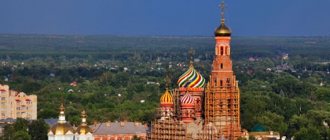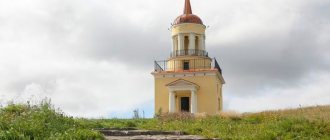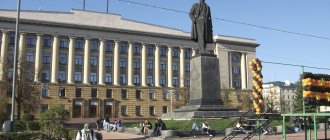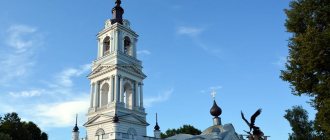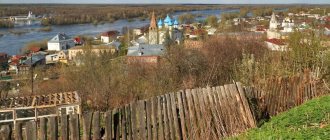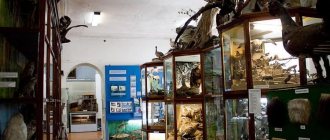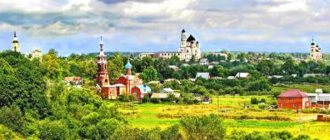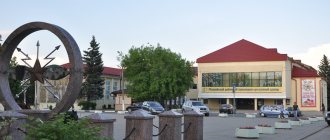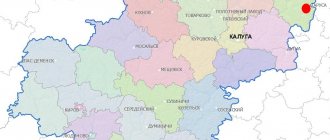The history of the city began in 1756, when, through the efforts of industrialist Akim Maltsov, a glass factory and an art school that trained masters in crystal processing arose on the banks of the Gus River. Over time, the small factory village turned into an interesting city, rightfully one of the attractions of the Russian Golden Ring. Today Gus-Khrustalny is a large industrial, cultural and historical center of the Vladimir region, which has retained its original specialization - the production of glass and crystal products.
GEORGE'S CATHEDRAL
Leonty Benois, the author of the project for St. George's Cathedral, wrote: “... I put everything I could into this temple, and perhaps it will remain the best of my creations.” This temple is a completely unique architectural monument both in design and execution - a three-nave basilica with a colonnade made of black labradorite, whose facade is made in the style of ancient Russian architecture. The famous artist V.M. worked on the interior of the temple. Vasnetsov – his brush is responsible for the stunning painting “The Last Judgment”. Also, based on Vasnetsov’s sketch, the mosaic panel “The Gracious One Rejoices in You,” located in the altar part of the cathedral, was made.
In the 1920s, the temple was converted into the Palace of Labor, and much of the original design was lost. At the end of the last century, Vladimir restorers managed to restore the white stone portals, mosaics, and carved doors of huge doors. St. Petersburg took part in the restoration of the unique painting “The Last Judgment . Currently, the building of St. George's Cathedral houses one of the most interesting attractions of Gus-Khrustalny - the Maltsov Crystal Museum.
Address: Gus-Khrustalny, st. Kalinina, 2a. GPS coordinates: 55.61991, 40.65804.
Where to go with a child
The sights of Gus-Khrustalny will be of interest not only to adults, but also to children. Before you go to this city with the whole family, you need to make a trip plan so that each member enjoys the trip.
| Name | Services |
| Movie. | In this center, a child can watch new cartoons, visit attractions and a trampoline center. In addition, theater and animation performances are held here. |
| Children's cafe "Chunga-Changa". | In this cafe you can try delicious and healthy food, relax in the games room or play board games. |
| Children's club "Antoshka". | The whole family can have a great time at this club. There are about 100 different attractions here. In addition, the club has a shooting range, board games and animation shows. |
| Crystal Museum. | The museum will be interesting not only for adults, but also for children. Here, in addition to traditional excursions, excursions are held specifically for children and master classes have been developed on making toys from glass and crystal. |
| Puppet Theatre. | This theater will be interesting for a child of any age. Here, in addition to traditional fairy-tale performances, festivals, children's parties and interactive excursions are held. |
CRYSTAL MUSEUM NAMED AFTER MALTSOV
Gusev crystal owes its worldwide fame, among other things, to one tragic event. In 1828, the owner of the Gusev crystal factory I.S. Maltsov was a secretary at the Russian mission in Persia - and was the only survivor of an attack by a maddened crowd on a group of Russian diplomats led by A.S. Griboyedov. To atone for his guilt, the Shah of Persia gave the Russian emperor one of his best diamonds, and gave Maltsov the right to duty-free trade in crystal in Persia. Thus, the Gusev factory acquired an extensive sales market and considerable funds for the development of production. In addition to Persia, the products of Gusev craftsmen were very popular in Central Asia and Transcaucasia.
The Crystal Museum was founded in 1983 and currently its collection includes more than 2,000 unique exhibits. Here you can see pre-revolutionary products that at one time won prizes at exhibitions in Vienna, Paris and Chicago; products of the first Soviet years - reflecting the main milestones of the country's development (“Five-Year Plan in Four Years”, “Spartakiad of the Peoples of the USSR” and others); modern author's works, among which “Hymn to Glass” stands out.
Address: Gus-Khrustalny, st. Kalinina, 2a. Coordinates: 55.6199, 40.65783.
MONUMENT TO MALTSOV
The monument to the merchant, industrialist and founder of the city Akim Vasilyevich Maltsov was erected in 2006 in honor of the 250th anniversary of Gus-Khrustalny. In his papers there is a record of the founding of the city: “Mother Moscow, what a great city it is, and even then it’s called by the river... I’ll order you to write in the papers: Gus-Khrustalny. Here the place is indicated and what product we will work on.”
It was Akim Maltsov who opened crystal production on the banks of the Gus River and laid down the highest quality standards for its products, which subsequently made local craftsmen famous throughout the world.
Address: Gus-Khrustalny, st. Kalinina, 2a. Coordinates: 55.61975, 40.6584.
general information
Gus-Khrustalny is located in the Vladimir region and is the center of the municipal district. The history of the settlement began with the founding of a glass factory by merchant A.V. Maltsov. This happened in 1765 on the Gus River. Over the years, production expanded and gradually became the largest in Europe.
The village where the workers settled began to be called Gus-Khrustalny. And at the beginning of the 20th century it was given the status of a city.
BUILDING OF A FORMER MEN'S SCHOOL
The former men's school, built in the 19th century in the Russian-Byzantine style, consists of two red-brick buildings and forms a single architectural ensemble with the nearby St. George's Cathedral. It was built by architect V.A. Pokrovsky, students of L.N. Benoit - the creator of St. George's Cathedral. Currently, the Historical and Art Museum is located in one of the school buildings, and the other is occupied by the Gus-Khrustalny Department of Education.
Address: Gus-Khrustalny, st. Kalinina, 2. Coordinates: 55.61882, 40.65968.
About 70 km south of the city of Vladimir, in the Meshchera Lowland on the banks of the Gus River, there is an unusual city with the bright name Gus-Khrustalny. I first met him back in July 1999, as a student, going with my supervisor to a conference held not far from this beautiful provincial city. Yes, then we were only passing through here, stopping at the crystal market, and driving past the Maltsovsky houses along the main street, but that was enough for us to look for a reason to return here for the next 19 years. Until, finally, a sudden love for crystal, admiration for its shapes, cuts, magical play of light, led to the fact that, waking up one morning, we decided: today we are going to Gus-Khrustalny!
Summary:
We are going, after 19 years Sights of Gus-Khrustalny Our impressions of the trip Reference information Hotels in Gus-Khrustalny
In Moscow that day it was cloudy and rainy, and the Vladimir region and the villages neighboring the city greeted us with beautiful sunny weather, endless forests giving way to endless open spaces, cute houses with carved frames on the windows, such a truly Russian atmosphere and the feeling that this It will be an unforgettable trip.
At the entrance to the city of Gus-Khrustalny from the side of Vladimir, there is a stele on which the year 1756 is indicated.
In short, it was from this time that the history of the city of Gus-Khrustalny began, when Akim Maltsov, as a result of a decree ordering a number of factories to be stopped within a 100 km radius around Moscow, transferred his production from Mozhaisk district here, to the bank of the Gus River, where in 1756 and a new glass factory was founded. The most advanced, promising technologies were used in production, special attention was paid to the exchange of experience with other glass factories, and the best craftsmen were invited. Later, the plant began producing crystal products and received, without exaggeration, the name “Gusevsky Crystal Plant”, recognizable all over the world. Well, Gus-Maltsovsky, which bore this name until 1926, became the working village of Gus-Khrustalny, receiving the status of a city in 1931. We have always been interested in how this or that city name was formed. So, the Gus-Crystal City received the name due to the fact that on the banks of the Gus River the production of high-quality crystal, famous far beyond the city and even the country, was established; such an elegant and sonorous name, well, as it seems to us.
Unfortunately, there were also very sad pages in the history of the city and the plant. Thus, in 2010, Gus-Khrustalny lost its status as a historical settlement, and at the end of 2011, crystal production at the plant, which once gave its name to this wonderful city, completely stopped. After talking with local residents, we heard several versions of what happened. But there’s probably no point in describing them, especially since we don’t know the exact cause of the near disaster at the city-forming enterprise. The main thing is that already at the end of 2013 the situation began to change for the better, when crystal production was resumed in one of the plant’s workshops. Here they didn’t quite understand, they say that the supposedly resumed production was now aimed at individual orders, and only for colored crystal. In the end, we found in the store a huge selection of all kinds of crystal products, both colored and transparent. Below we will post a photo from a store from this plant, you will understand what we are talking about. In the meantime, let’s explain why we even started talking about the sad? Yes, just before visiting Gus-Khrustalny again, of course, we read a lot of reviews. And, alas, not all of them were inspiring. And yet, somewhere deep down we believed that the situation here had begun to change for the better - we were not mistaken. It was a very bright and memorable trip with good acquaintances, we saw a lot of interesting things, although not everything, naturally, we bought crystal products for ourselves, family and friends in Crete. In general, having parked the car near the reservoir, which, by the way, is a very picturesque place, the first thing we decided to do was find a store at the factory.
Reservoir embankment on the street. Kalinina
First impression: the residents of the city of Gus-Khrustalny are very hospitable and friendly, they are absolutely amazing people. To find out how to get to the plant, we turned to a taxi driver who was standing leaning on his car, waiting for a client. Hearing our question, the taxi driver closed the car and led us towards the turn where we should have turned to find the plant.
True, having already said goodbye to the taxi driver, when we reached the plant, our first and, fortunately, last disappointment awaited us. The store at the factory was closed that day, with a chain and lock; to be honest, we haven’t seen anything like this for a long time. And the appearance of the factory buildings, to put it mildly, upset us. To be honest, we are a little depressed... We won’t post photos, because we sincerely believe that soon everything here will change for the better. Production has resumed, there is clearly interest in crystal, which means everything will be fine. What about the crystal products we wanted to buy here? It’s okay, it means, next time, and we didn’t come here only for them. Most of all I wanted to get to know the city itself and at least some of its attractions. But first of all, we really wanted to visit... But now we’ll tell you.
Sights of the city Gus-Khrustalny
In general, before the trip, having figured out which attractions we would have time to see and which ones we wouldn’t, we planned the day like this (we’ll post our list with addresses here):
- Crystal Factory (Kalinina St., 28)
- St. George's Cathedral and the Crystal Museum (Kalinina St., 2a)
- Almshouse (Kalinina St., 1)
- Gus-Khrustalny Historical and Art Museum (Kalinina St., 2)
- Shopping arcades (Kalinina St., 30)
- Holy Trinity Church (Luxemburgskaya str., 3)
- Church-chapel of the Holy Great Martyr Barbara and the holy spring (2nd Narodnaya St., 30)
- Maltsovsky houses (for example, on Old Bolsheviks Street, Lenin Street, Gogol Street)
- Reservoir embankment (Kalinina St.)
Of course, we also really wanted to see, at least with one eye, the Meshchera National Park, but we understood that we couldn’t do everything in one trip. And we assume that even a partial acquaintance with the park may take more than one day.
Well, we enjoyed a walk along the embankment of the reservoir, having just parked the car, we weren’t very lucky with visiting the plant that day, and after that, hurray, the first, truly brightest impression:
St. George's Cathedral and Crystal Museum
In general, having previously seen St. George's Cathedral only in photographs, even having thoroughly studied its history, we initially went here to the Crystal Museum, which since 1983 has been located in the building of the former temple. But then they could not yet imagine how unusually beautiful in reality, literally saturated with art, the St. George Cathedral itself would turn out to be, founded in 1892 at the expense of, without exaggeration, a man with a capital M, a generous benefactor and philanthropist Yuri Stepanovich Nechaev-Maltsov.
St. George's Cathedral in Gus-Khrustalny
You know, having recently studied the biography and life path of Yu. S. Nechaev-Maltsov, we are truly admired by the breadth of soul, generosity, and character of this man. It’s very difficult to find words... We recommend reading: link >> The cathedral was built between 1892 and 1903. designed by the talented architect Leonty Nikolaevich Benois and in 1903 it was illuminated in honor of St. George the Victorious. St. George's Cathedral was decorated by the artist Viktor Mikhailovich Vasnetsov, but, unfortunately, to this day only the canvas “The Last Judgment” measuring 7x7 m, which is located above the entrance, in the western part of the cathedral, and the mosaic “Rejoices in You, O Blessed One,” have survived to this day. made by the famous St. Petersburg mosaicist Vladimir Aleksandrovich Frolov based on the sketches of Viktor Mikhailovich Vasnetsov in the altar, eastern part of the cathedral.
To our greatest regret, in 1923 evil plans appeared, which very soon turned into a reality that is difficult to believe - St. George's Cathedral was closed and subsequently the Palace of Labor, a cinema, a music school, a library were located here, in a word, anything but a church . The temple itself was partially rebuilt, the domes were demolished, the bell tower was dismantled and the bells were melted down, the upper part of the cathedral was redone, and the interior was divided into two floors. All the valuables of the temple, including paintings, were taken away. The canvas “The Last Judgment” was folded, which is why, over time, abrasions appeared on the folds, the lower part of the painting was torn, and later the canvas was straightened and screwed onto a pole. Its condition was in a deplorable state, and only 60 years later, thanks to caring people who took timely measures and titanic restoration work, the painting was restored and in 1983 returned to the St. George Cathedral in the city of Gus-Khrustalny. In the same year, the Crystal Museum opened in the cathedral.
During the conversion of St. George's Cathedral into the Palace of Labor, the workers did not tear off the mosaic “Rejoices in You, O Blessed One,” in the altar part of the church, but simply covered it with whitewash, deciding that it would be easier for them. We can say that, fortunately, thanks to this and the subsequent painstaking work of the restorers, it was possible to preserve the unique work of V. M. Vasnetsov and V. A. Frolov, which we have the opportunity to enjoy today.
Alas, not all of the works of Viktor Mikhailovich Vasnetsov were destined to return to the cathedral (some of them, if we understand correctly, are currently stored in the State Museum of the History of Religion in St. Petersburg), and the cathedral itself still stands without domes and chapels . But how beautiful it is, what amazing harmony and sophistication in the details, what an elegant combination of red brick with massive white portals, columns, window frames, and white stone cornices. We just walked around the cathedral for about an hour, studying the smallest details, enjoying the ingenious solutions of Leonty Nikolaevich Benois used in the construction of the cathedral, which, by the way, became one of the best creations of the architect, admiring the painstakingly completed restoration work carried out in the period from 1973 to 1983. and partially restored the cathedral to its original appearance.
Having purchased a ticket to visit the Crystal Museum, we noticed a glass shelf in which crystal products were displayed for sale. The choice was not very large, but we liked something, we turned to the museum employees... And here again a little about the local residents. In response to our request to show the crystal figures we liked, we were told: “Let’s put them aside for you until the evening, but first you will visit the museum where you have already bought a ticket, enjoy the interior of the cathedral, the exhibition, and then go to a large crystal store, which recently opened in Trade Rows. There’s more choice there and, you’ll see, if you come back to us, it won’t be for delayed goods, but back to the museum,” and they smiled kindly. It’s incredible, no one persuaded us to buy anything, on the contrary, they helped us so much, they told us where to find a truly huge selection of crystal factory products, amazing!
Having entered inside the cathedral, we, without exaggeration, were speechless, they tell us something, but we stand and cannot move from what we see: the huge space of three naves, flooded with light penetrating inside the cathedral, including through the upper windows of the central nave , large carved doors, arched openings supported by massive columns made of labradorite, impressive in size by V.M. Vasnetsov, and in the center, as the guide subtly noted, as if a river of crystal flows to unobtrusively sounding music, setting a special mood.
We noticed that there was a crystal chandelier hanging in one of the arches, but there was only one of its kind. The guide said that there used to be more chandeliers, but, unfortunately, only one was preserved. By the way, its weight is almost more than 300 kg.
In general, it is amazing how harmoniously the crystal exhibition is located here, what a play of light, emphasizing the elegance of lines and the art of cutting, what a mood, with an invisible thread, connecting ancient and modern works of talented Gusev craftsmen - a complete immersion in the history of glassmaking in the city of Gus-Khrustalny. We made the first circle, studying the exhibits, even forgetting to take out our cameras. We took photographs after, but, to be honest, in our opinion, not a single photograph can convey the details, inexplicable radiance and sophistication of the forms of this or that crystal product. But still, we couldn’t help but take a photo of this magnificence as a souvenir.
Under the mosaic “She rejoices in you, O Blessed One,” there is a massive, impressive composition “Hymn to Glass” (in reality, this composition is much larger than it seems in the photograph):
And to the right and left there are three-meter sketches depicting the Seraphim for the mosaic panel “She rejoices in you, O Blessed One”:
We left the cathedral in some inexplicable state of admiration, surprise... words cannot express it. Once again we walked around St. George's Cathedral,
We walked along the alley in front of the cathedral, where there is a monument to Akim Maltsov.
At the stands in the alley, we studied historical photographs of the city and its attractions with great interest.
Address of St. George's Cathedral: Vladimir region, Gus-Khrustalny, st. Kalinina, 2a; Approximate coordinates of the cathedral: 55°37'10.8″N, 40°39'28.6″E (55.619665, 40.657940).
Almshouse
To the southwest of St. George's Cathedral in 1897, an Almshouse was erected - a one-story building that had some architectural resemblance to a temple. Of course, the building of the Almshouse was also designed by L. N. Benois. Later, it also underwent major changes - a second floor was added, which, in our opinion, is architecturally noticeably different from the creation of L.N. Benois.
Nowadays, this building houses the Administration of the city of Gus-Khrustalny.
Almshouse address: Vladimir region, Gus-Khrustalny, st. Kalinina, 1; Approximate coordinates of the Almshouse: 55°37'08.9″N, 40°39'26.0″E (55.619131, 40.657215).
Gus-Khrustalny Historical and Art Museum
South-east of St. George's Cathedral, at the intersection of st. Kalinina from st. Gogol there are two, like a mirror image of each other, buildings, in the past the Men's Primary School, erected according to the design of the architect V. A. Pokrovsky, a student and assistant of L. N. Benois. We learned about this a little later, from a local resident. Then this explains a lot, in particular, the quite clearly visible, in architectural terms, similarity with St. George's Cathedral and the Almshouse.
Nowadays, in one of the buildings there is the Gus-Khrustalny Historical and Art Museum, which, alas, we were not able to get into. To be honest, we just slightly violated our own plan of walking around interesting places, and we were simply carried away by other attractions of this wonderful city. Well, there will be a reason to return to Gus-Khrustalny. Well, by the way, we now have much more reasons to return here.
Museum address: Vladimir region, Gus-Khrustalny, st. Kalinina, 2; Approximate coordinates of the museum: 55°37'08.5″N, 40°39'35.1″E (55.619029, 40.659746).
Shopping arcades
We changed our plans in favor of a crystal store, which was located in the Trading Rows, which the employees of the Crystal Museum told us about. And, since we are in such an interesting city as Gus-Khrustalny, a simple trip to the store turns into a little adventure. Look, when we park our car, it’s like we’ve stepped back into the past:
Incredible, this is the legendary Volga GAZ-21! And against the backdrop of the Lenin monument, even now, looking at this photograph, it seems that we are back in the 60s of the last century.
And the shopping arcades themselves, built back in 1853, cannot help but attract attention. The facade of the two-story red building is decorated with large white stone columns, long balconies with simple but effective balustrades. Initially, there were shops inside where factory workers could buy food and dry goods. There was a time when the Trading Rows were closed, but today trade is taking place in the historical building again.
Actually, here we found a crystal store, where we had a little break, unable to stop our running eyes in time. But oh well, it will all be a memory of that bright trip. It’s funny, but having discovered a lock on the factory doors that day, we no longer thought that we would be able to make so many purchases. Returning to the topic of temporary stoppage of production, subsequent resumption and production of crystal, supposedly only for individual orders, and only colored crystal. We look at the following photograph and what we heard does not agree with what we saw:
But oh well, it will all be a memory of that bright trip. It’s funny, but having discovered a lock on the factory doors that day, we no longer thought that we would be able to make so many purchases. Returning to the topic of temporary stoppage of production, subsequent resumption and production of crystal, supposedly only for individual orders, and only colored crystal. We look at the following photograph and what we heard does not agree with what we saw:
And how many interesting things were told to us about the history of the plant by the employees of this store, about the technology of glass blowers, about unique crystal products, sometimes made in single copies for famous TV shows, various societies, and about the sad pages of the history of the plant, and about the resumption of production with joy in the voice and hope told about a bright future. In general, in the end we talked more and got the impression that we had been on an interesting excursion, that’s how the locals are!
Address of the Trading Rows: Vladimir region, Gus-Khrustalny, st. Kalinina, 30; Approximate coordinates: 55°36'53.8″N, 40°40'12.4″E (55.614953, 40.670104).
Holy Trinity Church
The history of this temple dates back to 1816, when the Joakimoan Church was erected in the village of Gus, consecrated in honor of the Holy Righteous Fathers Joachim and Anna. A little over thirty years later, with an increase in the number of parishioners, a heated meal was added to the church, consecrated in honor of the Holy Life-Giving Trinity. Later, the temple became fully heated; moreover, it was distinguished by its rich interior decoration, some elements of which were made by local craftsmen.
But, to the greatest regret, this temple also suffered the fate of St. George’s Cathedral - in the period from 1936 to 1940. (data vary) a decision is made to close the church, the premises are partially re-equipped to meet the needs, first of the workshops of the glass technical school, then, in the post-war years, of the warehouse. It’s hard to wrap your head around it, but it’s impossible to comprehend what happened next without bitterness... from 1949 and for more than 30 years, a fire department was located here, the main means of transport of which were horses that lived inside the church.
And only 1989 became a turning point for the temple, when, after an endlessly long break, the long-awaited liturgy was finally served, the church was renamed the Holy Trinity Church and large-scale restoration began, including the removal of paint from the wall paintings, the dismantling of the “new building” "in the altar part. Fortunately, we managed to preserve the ancient icons of this church, as well as icons and parts of the iconostasis from other churches, but the main thing is that the Holy Trinity Church became operational again!
We did not take photographs inside the church, we did not even find out whether it was possible to do so or not. And, to be honest, we didn’t want to, because visiting him was something more for us, something personal that cannot be expressed in words. Another such place for us was the Church-Chapel of the Holy Great Martyr Barbara.
Address of the Holy Trinity Church: Vladimir region, Gus-Khrustalny, st. Luxemburgskaya, 3; Approximate coordinates of the temple: 55°36'49.6″N, 40°40'16.6″E (55.613781, 40.671276).
Church-Chapel of the Holy Great Martyr Barbara
The history of this beautiful chapel dates back to 1765, then on the banks of a small river, a tributary of the river. Goose, the icon of the Holy Great Martyr Barbara appeared. After this event, the river acquired the name “Varvarka”, and a small wooden chapel appeared at the site of the appearance of the icon. Later, already in 1882, the construction of a stone chapel began in its place, which lasted 3 years. The result was an amazingly beautiful chapel with a separate room for the holy spring. By the way, since 1817, processions of the cross from Joachimoan Church (now the Holy Trinity Church) have been held to the chapel.
We arrived at the chapel at 14:55 and were sad to discover that visiting hours that day ended at 15:00, i.e. in five minutes. But we still opened the gates so that at least from afar we could enjoy the beauty of the architecture, and in general, the place here is of extraordinary beauty. Outside the gate we were met by a church minister who had already closed the chapel and church shop. Seeing us, she inquired about where we had come from and, having learned what path we had taken, despite all our embarrassment and unwillingness to distract us, she took us by the hands and led us to the chapel, telling the story of her miraculous appearance, about the appearance of the icon of the Holy Great Martyr Barbara, how the stone chapel was erected.
With obvious bitterness in his voice, we were told the story of the difficult fate that, along with other temples, befell this place when in the 30s of the last century the chapel was closed, and inside it housed everything: the production of candy, and a workshop. funeral home, and garage. In the middle of the last century, the chapel was damaged several times by fires, one of which completely destroyed the vaults. Fortunately, in 1991, bright pages began in the history of the chapel, when it was returned to the believers, its restoration began, almost by the whole world. A few years later, an altar appeared in the chapel and an independent St. Barbara’s parish was registered. The servant drew our attention to the beautiful painting of the ceiling and walls inside, to the ancient icons, and paid special attention to the recently painted icons, which, surprisingly, have already created many miracles for the parishioners of the temple!
It’s incredible, we were given such a welcome during non-working hours, we were told and shown so many interesting things, we were already infinitely grateful, but the attendant again took us by the hands and led us to the southern part of the temple, where the holy spring is located, to which she allowed us to fall, showed a stone on which the foot of the Holy Great Martyr Barbara is visible; it lies on the street next to the room in which the holy spring is located. A little to the south there is a small pond, dug relatively recently, in 1997, but which has already become one of the main places for the townspeople where Epiphany bathing takes place.
Some unreal impressions, such bright feelings from everything that was happening, from what was seen, from communicating with hospitable local residents, from the sights seen, which, in principle, I don’t even want to call them such, because this is part of the history, part of the life of this amazing city.
Address of the Temple-Chapel of the Holy Great Martyr Barbara: Vladimir region, Gus-Khrustalny, st. 2nd Narodnaya, 30; Approximate coordinates: 55°36'15.4″N, 40°40'36.2″E (55.604282, 40.676732).
By the way, we completely forgot to talk about another attraction of Gus-Khrustalny, more precisely, nevertheless, an architectural feature of the historical part of the city. You probably already guessed that we will talk about the famous Maltsov houses.
Maltsovsky houses
Imagine streets with almost identical one-story red brick houses, large vaulted windows, decorated with white frames of various shapes, and gable roofs. No, the houses, of course, are slightly different from each other: different frames around the windows, different numbers of windows on the facade.
It is also interesting that if it weren’t for the beautiful birch trees, in the shadows of which these unusual Maltsov houses hid, then sometimes one would think that we are now not in a city in the Vladimir region, but on the streets of, say, an English town. By the way, as the taxi driver said, remember, who accompanied us to the turn to the crystal factory, we should definitely pay attention to these houses, of which, it’s hard to believe, more than 400 were built in Gus-Khrustalny at one time. They were built from the middle of the 19th century. to the beginning of the 20th century for workers of the Maltsovsky factories, hence the common people’s name “Maltsovsky houses” or “Maltsovsky halves”. Why halves? Yes, it’s just that each such house was divided into two parts and was designed to accommodate two families. It is interesting that the families of important production workers lived in the part of the house that faced the street, while the windows of the apartments of the families of less valuable workers faced the courtyard. On some houses you can still see the border along which the apartments are divided, but for some reason we forgot to photograph it. By the way, it turns out that in our time the Maltsov houses are classified as objects of cultural heritage, and in fact are also a real architectural symbol of the city of Gus-Khrustalny. Fair enough, because this is exactly how I remembered Gus-Khrustalny 19 years ago.
Where are the Maltsovsky houses located? When they told us: “Be sure to check out the Maltsov Houses,” we didn’t know exactly where to find them. But it turned out to be simple, just, for example, turn off the street. Kalinina on the street Old Bolsheviks, st. Lenina, st. Gogol. More precisely, we met them on these streets, but we are almost sure that there are many more such streets in the city, which is why it is difficult to find any exact coordinates of Maltsov’s houses.
Our impressions
We came here having read completely different opinions about the city of Gus-Khrustalny, some speak about it with inspiration, that’s how we do. But we also came across strange reviews about some kind of “depression” and so on, with which we personally do not agree at all. After all, a lot, it seems to us, depends on the mood with which we came here. This is a wonderful, beautiful city with unique architectural monuments, rich history, and amazing local residents. And what is the nature like here, Meshchera, the forests around, picturesque open spaces, beautiful villages. And if a person sets out to look for something bad, it can be found even in the most ideal places, believe me, we know what we are talking about. Our impressions? There is definitely something to see and admire in the city. And we haven’t seen everything yet. Yes, we came across old buildings, unfortunately still in a deplorable state, and yes, the city-forming plant is far from working at full capacity. But a lot has changed for the better in the city, even compared to what I saw 19 years ago. I repeat, amazing people live here, interesting, positive, very hospitable, ready to help, tell interesting facts about their city, there are so many architectural monuments, sometimes entire streets (where else can you see this?). And here, too, crystal was produced and, fortunately, continues to be produced, famous far beyond the city, the same crystal that gave this city such a beautiful name - Gus-Khrustalny!
Will we come back here again? Absolutely, there is no doubt at all. After all, we haven’t seen so much yet, we want to go on an excursion to the plant’s production, visit the National Park, visit museums that we didn’t have time to go to this time. But the main thing is that there is something in Gus-Khrustalny that has drawn me here all these 19 years, and now draws me with renewed vigor, now for Irina and me. There were thoughts of repeating the trip in the fall of 2021, but these operations and a series of other events changed our plans. We'll come back, sooner or later we'll definitely come back here.
Alexei
Reference Information:
- Where is Gus-Khrustalny located? The city is located in the Vladimir region, approximately 235 km east of Moscow, 70 km south of Vladimir.
- City coordinates: 55.614947, 40.670794.
- How to get to Gus-Khrustalny? We were traveling from Moscow, so we’ll tell you about this option. Although, in any case, we would first get to the city of Vladimir, from where you can get to the city of Gus-Khrustalny by bus, or by rail on the Vladimir - Tuma train. We preferred to go by car, since it was the easiest and did not have to change trains. In the direction of Gus-Khrustalny we drove along the Gorkovskoye Highway (M7) to Vladimir, then turned onto the P73 highway (Vladimir - Gus-Khrustalny - Tuma). On the way back, for a change, we drove south along P73 to the city of Tuma, then along the P105 highway (Egoryevskoye Highway) towards Moscow.
- Are there any hotels in Gus-Khrustalny and the surrounding area? Yes, there is, you can look here: * List of hotels on Booking.com >> * List of hotels on Hotellook >>
- Excursions around Gus-Khrustalny and the surrounding area : on Tripster.ru.
HISTORICAL AND ART MUSEUM
The Gus-Khrustalny Historical and Art Museum opened on June 18, 2011, on the day of the 255th anniversary of the city. It is located in the historical building of the men's Primary School, built in 1898, and offers its guests two interesting exhibitions: “The Goose Museum” and “The Stone Chronicle of Meshchera”, telling about the nature of the Meshchera region, the history of its development and about the goose - the ancient sacred totem of its inhabitants.
Address: Gus-Khrustalny, st. Kalinina, 2. Coordinates: 55.61872, 40.65979.
GUSEVSKY CRYSTAL FACTORY
The enterprise was founded by industrialist Akim Maltsov in 1756 - and over time, the factory village turned into a city called Gus-Khrustalny. As the enterprise developed and the skills of its workers improved, the fame of Gusev crystal expanded - many well-known companies, for example, the Carl Fabergé Trading House, were customers of the plant.
The fate of the plant had its ups and downs - for example, after the 2008 crisis, it was completely closed and its employees were fired. However, in 2013, production was restored again - now the workshops have new modern equipment, on which craftsmen make their unique designer products. The most interesting of them can be seen in the Crystal Museum (point 2 of this article).
Address: Gus-Khrustalny, st. Kalinina, 28. Coordinates: 55.61564, 40.66792.
Glass market
Even if you have already bought crystal from a factory, still visit the local glass market. On it you will find crystal, glass, ceramic and clay products from different countries. Among the producers are other cities in Russia, Ukraine, Belarus, and Turkey.
Glass market
You can buy a cute souvenir as a gift or as a keepsake, or you can buy something useful in everyday life (for example, chandeliers, vases, sets).
- Where is it: st. Rudnitskaya, 10.
- Opening hours: daily from 6:00 to 13:00.
- Cost of visiting: free.
TRADE RANKS
Shopping arcades are an invariable attribute of almost all cities of the Russian Golden Ring - Kostroma , Suzdal , Yuryev-Polsky and others. Gusevsky shopping arcades were built in the middle of the 19th century and were originally called the “Shop House of Haberdashery Manufactories and Food Supplies.” Architecturally, they are a two-story red brick building with white columns and balconies on the second floor. To this day, the shopping arcades are used for their intended purpose - they house many shops and stalls. In addition, here is one of the best restaurants in the city - Maltsov, specializing in traditional Russian cuisine.
Address: Gus-Khrustalny, Freedom Square. Coordinates: 55.61497, 40.66966.
Train Station
Perhaps this is the very first place that visitors to the city see. Of course, the station should leave such an impression so that it is preserved not only when visiting Gus-Khrustalny, but also after the trip. And this impression remains.
Train Station
The railway station was built in 1956. The building is spacious, but, unfortunately, is now mostly empty. The reason is the low train flow. The building itself was built in a classical style. This is manifested in columns and cornices, platbands and portals. All decorative elements are painted white. For those who want to take a beautiful photo, there is a special photo zone nearby.
- Where is it: st. Vokzalnaya, 2.
HOLY TRINITY CHURCH
This temple was built by one of the heirs of Akim Maltsov, a retired cornet of the Life Guards Cavalry Regiment, Sergei Maltsov. Work began in 1811, but the Patriotic War that began a year later did not allow the work to be completed on time - the temple was commissioned only in 1816. Initially, the temple was consecrated in honor of Saints Joachim and Anna, and fairs were held on the church square twice a year (in the summer on Trinity and in the fall on Joachim and Anna), attracting merchants from all over the Vladimir region.
With the advent of Soviet power, the temple was closed, and its premises began to be used as a warehouse, workshop, and fire department. Only in 1983 the Holy Trinity Church was recognized as an architectural monument and its active restoration began.
Address: Gus-Khrustalny, st. Luxemburgskaya, 3. Coordinates: 55.6137, 40.67154.
MALTSOVO HOUSES
The famous Maltsov houses were built by the owners of the Gusev crystal factory for their workers - one of these houses can be seen on Oktyabrskaya Street. Now these are ordinary private residential buildings, but thanks to their uniform style they can easily be distinguished from other buildings in the city - they stand out for their small size, red brick and white windows.
Maltsovsky houses are considered an object of cultural heritage of the city, so being their owner is not easy - by law, the owner is obliged to monitor their condition and appearance, and make repairs on time.
Address: Gus-Khrustalny, st. Oktyabrskaya. Coordinates: 55.61467, 40.67627.
CHAPEL OF ST. BARBARA
The current stone chapel building was built in 1855 - at the same time a well was built over the nearby holy spring. The chapel was erected on the site of the miraculous discovery of the icon of St. Barbara, which then became her main shrine. In the 1930s, the chapel was closed and a catering unit was located in it - gingerbread cookies were baked here and syrup for children's lollipops was made.
It is interesting that almost every year on the eve of the feast of St. Barbara there was a fire in the building - during one of them the wooden vaults were destroyed. In the 1970s, the catering unit was replaced by a garage, and gradually the holy spring became littered with automobile waste. Only after the decline of Soviet power in 1991, the knowledge of the chapel was returned to the believers and its restoration began by the efforts of parishioners and city residents.
Address: Gus-Khrustalny, 2nd Narodnaya Street, 30. Coordinates: 55.60424, 40.67668.
Almshouse
The building of the former almshouse is one of the most striking and outstanding architectural monuments that have survived to this day. Built according to the design of architect L.N. Benoit in 1897, the originally one-story stone building with a high roof was modernized by the Soviet authorities in the 30s of the 20th century. But the resulting result exceeded all expectations - the dismantled “epanch” roof was replaced with a wooden second floor. But the Soviet architects did not forget about the decor of the facade, the central place of which was occupied by four columns in the eclectic style - this is a completely unheard of generosity for a provincial town devastated by the Civil War and the young country of the Soviets that had not fully recovered from all the shocks.
Initially, the almshouse was used for its intended purpose - housing and caring for elderly glass factory workers. But from the Soviet period to the present (2021), the premises have been converted and are used for the needs of the city administration of Gus-Khrustalny.
Address : st. Kalinina, 1, Gus-Khrustalny, Vladimir region, 601501
PARK "FAIRY TALE"
“Skazka” is a rather dense forest, where among the trees you can find heroes of Russian fairy tales and legends carved from wood. Their figures were created by local artist Valery Kiselyov, who breathed new life into the previously existing, but decayed and abandoned park. The central place of the park is occupied by a picturesque lake, where you can relax in peace and quiet and recharge with the energy of living nature.
Coordinates: 55.62739, 40.70127.
MESCHERA NATIONAL PARK
Gus-Khrustalny is an ideal access point to the “pearl” of the Vladimir land – the Meshchera National Park. The park was created in 1992 to preserve the unique nature and cultural and historical heritage of the Meshchera Lowland. On the site of the modern Meshchera park, archaeologists discovered several ancient burials, confirming that the Vladimir land was inhabited in prehistoric times.
There are many marked ecological routes throughout the park, allowing you to be alone with yourself and nature, and enjoy the peace and tranquility of the Russian forest. Along the routes there are information stands, rest areas, and camping areas. The park also offers its guests several interesting museums: “World of Birds”, “Russian Compound” and others. In addition, the Local History Museum is located in the village of Tasinsky.
Coordinates: 55.63423, 40.68988.
What to bring from Gus-Khrustalny
The city's attractions are mainly places associated with crystal production. The most basic souvenir that you can bring as a gift from Gus-Khrustalny is, of course, one made from this material.
So, as a keepsake in this city, sellers offer to purchase the following souvenirs:
- figurines made of colored glass;
- sets made of crystal, porcelain and glass;
- crystal bells;
- magnets and panels made of crystal and colored glass;
- chandeliers;
- piggy banks;
- toys;
- crystal bouquets and other decorative items.
Gus-Khrustalny is included in the cultural and historical heritage of Russia. The sights of the city and its surroundings are not only architectural objects, but also the stunning nature of the Meshchera region.
Article design: Mila Friedan
MUSEUM “WORLD OF BIRDS OF MESCHERA NATIONAL PARK”
This museum is located in the village of Urshelsky, not far from Gus-Khrustalny. Its exposition contains information about all species of birds living in the territory of the Meshchera National Park - the collection includes about 200 exhibits. The collection is divided into 4 exhibitions: birds of the forest, birds of rivers and swamps, birds of open spaces and domestic birds. In the museum you can learn about their way of life, look at the collection of eggs, and see rare birds listed in the Red Book and in need of protection.
Address: Urshelsky village, visit-. Coordinates: 55.66946, 40.22064.
TEMPLE OF THE LIFE-GIVING TRINITY
This church is located near the village of Erleks and is one of the largest and most beautiful in the vicinity of Gus-Khrustalny. It was built in 1825-1852 in the strict style of late classicism. The bell tower was built later than the main temple and is visually very different from it - it is already an eclectic style, with more intricate decorations on the facade.
Address: Erleks village, Gus-Khrustalny district. Coordinates: 55.60114, 40.38904.
MUSEUM "RUSSIAN COMPOUND"
The Russian Compound Museum is located in the Meshchersky National Park and is one of the most interesting attractions of both the park and the city of Gus-Khrustalny itself. The museum is a model of an ancient Russian settlement in the open air - with residential buildings, a church, a Russian bathhouse, a crane well and many other exhibits. All museum exhibits were created according to ancient records and drawings, with careful adherence to all rules and canons.
On the territory of the museum there is a shooting range where, under the guidance of an instructor, you can try your hand at archery and crossbow shooting.
Accommodation
The hotel network is poorly developed. Hotels offer mostly standard rooms. The best place to stay will be the Meshcherskaya Usadba park hotel. The hotel is located in a picturesque forested area 5 km from the city. It offers free Wi-Fi, parking, an indoor pool and a breakfast buffet. Each room is equipped with air conditioning.

